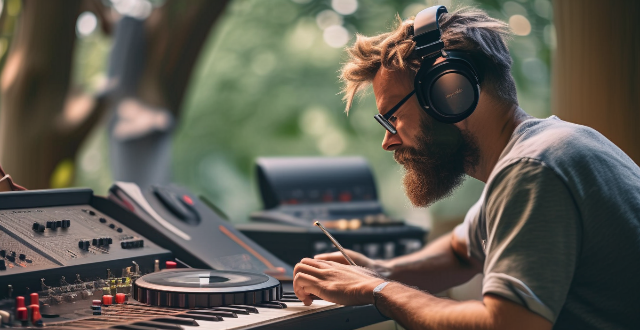Physical Music

How does music influence motivation during physical activity ?
Music has a significant impact on motivation during physical activity. Fast-paced music increases energy levels, slow-paced music promotes relaxation, and enjoyable music enhances mood. Music can also distract from pain and fatigue, and personal preference plays a role in its effectiveness. Incorporating music into workout routines can make exercise more enjoyable and lead to better results.

Can music help reduce perceived exertion during exercise ?
Music can help reduce perceived exertion during exercise by positively influencing mood and cognition, and acting as a distraction from bodily symptoms associated with fatigue. Numerous studies have shown the benefits of music on perceived effort levels during workouts, but individual preferences and contextual factors play significant roles. To potentially benefit from reduced perceived exertion, it's important to select music that resonates personally and matches the intensity of your workout.

Do different genres of music have varying effects on sports performance ?
Music is a powerful tool that can influence our mood, motivation, and overall performance in various activities, including sports. The question arises: do different genres of music have varying effects on sports performance? Let's delve into this topic to find out. ### Motivational Aspect - **Upbeat Music**: Fast-paced music with a high tempo, such as rock or electronic dance music, can increase energy levels and provide motivation during workouts or competitions. - **Relaxing Music**: Slow-tempo music like classical or instrumental tracks may help athletes relax and focus on their technique rather than intensity. ### Physical Response - **Heart Rate**: Upbeat music can increase heart rate, preparing the body for more intense physical activity. - **Muscle Response**: Some studies suggest that certain genres of music can affect muscle activation and coordination. ### Mental Focus - **Concentration**: Music without lyrics or with less distracting elements can help maintain focus during repetitive tasks or endurance events. - **Mental Toughness**: Aggressive or empowering music can boost mental toughness, helping athletes push through difficult moments. ### Recovery Process - **Relaxation**: Genres like ambient or yoga music can aid in recovery by reducing stress and promoting relaxation post-exercise. ### Genre-Specific Effects - **Rock/Pop**: Ideal for high-intensity workouts where an energy boost is needed. - **Classical/Instrumental**: Suitable for activities requiring precision and concentration. - **Hip-Hop/Rap**: The strong beats can serve as a rhythmic guide for exercises requiring timing and coordination. - **Electronic Dance Music (EDM)**: Suitable for interval training due to its ability to sustain high energy levels. - **Ambient/Yoga Music**: Helpful in recovery sessions by promoting relaxation and reducing tension.

Have any celebrities announced their retirement from acting or music lately ?
Recently, several celebrities have announced their retirement from acting or music. Some notable examples include actors Daniel Day-Lewis, Sir Ian McKellen, Julianne Moore, Christopher Plummer, and Gena Rowlands, as well as musicians Elvis Costello, Paul Simon, Kenny G, Oasis, and Take That. While some have cited a desire to focus on other pursuits or spend more time with family as their reasons for retiring, others have continued to release new music or perform occasional concerts despite stepping away from touring.

What is Apple Music ?
Apple Music is a music and video streaming service developed by Apple Inc. It offers access to millions of songs and videos from the iTunes Store, exclusive content, and personalized recommendations. Features include a library, personalized recommendations, radio stations, and artist connections through Connect. The service is available in over 100 countries and regions with various pricing options. It competes with other music streaming services like Spotify and Amazon Music.

What role does music play in team sports and group fitness classes ?
Music plays a crucial role in team sports and group fitness classes by motivating participants, setting the pace, enhancing enjoyment, fostering social interaction, improving mental toughness, and aiding recovery. It is used across various settings like yoga, cycling, basketball, and team-building activities to create a specific atmosphere or achieve a desired effect.

Can listening to music improve your mood during a workout ?
Listening to music during workouts can improve mood and performance. It boosts motivation, distracts from pain, enhances endurance, improves mental alertness, and creates positive association with exercising. Incorporate music into your workouts by choosing the right genre, making a playlist, investing in good headphones, and varying your music.

Can we expect any music videos for the songs in the new album ?
The text discusses the possibility of music videos accompanying a new album, considering factors such as the artist's history, label support, fan demand, budget and resources, and creative vision. The author expresses their hope for visual representations of the music to enhance the listening experience.

How does Apple Music compare to other music streaming services like Spotify or Tidal ?
This text compares Apple Music, Spotify, and Tidal in terms of their user interfaces, music libraries, audio quality, pricing, and additional features. Apple Music integrates seamlessly with Apple devices and offers personalized recommendations, while Spotify emphasizes social sharing and collaboration. Tidal focuses on high-quality audio and exclusive content from artists. The choice between these services depends on personal preferences and priorities when it comes to music streaming.

Can I use Apple Music without an Apple device ?
The text discusses the availability of Apple Music across various platforms, including Windows, Android devices, web players, and smart TVs and streaming devices. It highlights the key features available on each platform and concludes that users don't need an Apple device to enjoy Apple Music.

Is Apple Music available on Android devices ?
Apple Music is a popular music streaming service by Apple Inc., and it's not exclusive to iOS devices. It's also available for Android users. The availability of Apple Music on Android devices allows users to download the app from the Google Play Store and enjoy all the features that come with a subscription. To download the Apple Music app on an Android device, users need to open the Google Play Store app, search for "Apple Music" in the search bar, select the official Apple Music app from the search results, and click on the "Install" button to download and install the app on their device. Once downloaded and installed, users can start using the app right away and enjoy features such as music streaming, radio stations, playlists, sync across devices, and offline listening.

How does music affect athletic performance ?
Text is about how music can affect athletic performance. It explains the ways in which listening to music while exercising or competing can increase motivation, improve focus, reduce the perception of effort, and distract from pain and fatigue, leading to better performance and results.

Can listening to music help or hinder concentration ?
Listening to music can both help and hinder concentration, depending on factors such as the type of music, individual preferences, and the task at hand. Positive effects include increased motivation, improved mood, reduced stress, and enhanced creativity. Negative effects may include distractions, cognitive overload, emotional responses, and individual differences in musical preferences. To optimize the use of music while working or studying, consider choosing the right genre, adjusting volume, taking breaks, personalizing playlists, and experimenting with different types of music.

Does Apple Music have a free trial period ?
Apple Music offers a three-month free trial for new users, allowing them to explore its vast library and personalized recommendations without any charges. To sign up, users need to open the Music app or iTunes, click on the "Try it free" button, create an Apple ID (if needed), enter payment information, and start enjoying the service. It's important to cancel the subscription before the trial ends to avoid being charged.

How do I cancel my Apple Music subscription ?
This guide explains how to cancel your Apple Music subscription. The steps include opening the Settings app, tapping on your name, going to Subscriptions, selecting your Apple Music subscription, canceling the subscription, confirming cancellation, and checking for any remaining time. Canceling your subscription does not immediately stop your access to the service; you can continue using it until the end of your current billing cycle.

How do athletes use music to prepare for competitions ?
Athletes use music in various ways to prepare for competitions, including creating warm-up playlists, listening to calming music for mental preparation, using pump-up songs for emotional momentum, establishing consistent pre-game rituals, and incorporating music into recovery and relaxation routines. The strategic use of music can enhance focus, energy, and overall readiness for competition.

Can I share my Apple Music subscription with family members ?
The text provides a guide on how to share an Apple Music subscription with family members through the Apple Music Family Plan. This plan allows up to six people to enjoy all the features of Apple Music for a single monthly fee. The steps include subscribing to the Family Plan, inviting family members, accepting the invitation, and enjoying Apple Music together. The benefits of the plan include separate accounts, simultaneous use, personalized experience, offline downloads, and access to other Apple services. Sharing the subscription saves money and creates a shared musical experience within the household.

What are the best types of music to listen to while exercising ?
The best types of music for exercising include upbeat pop and dance music, rock and metal, hip hop and rap, electronic dance music (EDM), and classical music. Pop and dance music have fast tempos and catchy melodies that can keep you moving, while rock and metal provide the energy and aggression needed to power through your workout. Hip hop and rap are perfect for getting pumped up and motivated during exercise routines, while EDM has high energy and rhythmic beats that make it an excellent choice for workout playlists. Classical music may not seem like an obvious choice for exercise, but studies have shown that listening to classical music can improve focus and reduce stress levels, making it ideal for activities like yoga or Pilates.

How does South American music reflect its cultural diversity ?
South American music reflects the continent's cultural diversity through its rhythms, instruments, lyrics, and performance styles. The rhythm is characterized by complex patterns influenced by African, Indigenous, and European traditions. Traditional instruments like pan flutes and accordions hold cultural significance and provide unique sounds. Lyrics often convey narratives about history, social issues, and cultural traditions. Performance styles range from informal gatherings to large-scale events with elaborate costumes and choreography. Overall, South American music showcases the continent's vibrant culture while promoting understanding among different groups.

Are there any negative impacts of listening to music while exercising ?
Listening to music while exercising can have both positive and negative effects. Some potential drawbacks include distraction, reduced awareness of surroundings, hearing damage, discomfort, pacing issues, disruption of natural rhythm, isolation, and lack of feedback. By being mindful of these factors, you can minimize the negative impacts and maximize the enjoyment and effectiveness of your workouts.

Can I share my Apple Music subscription with family members using my Apple ID ?
Can I Share My Apple Music Subscription with Family Members Using My Apple ID? You can share your Apple Music subscription with family members using your Apple ID through the Apple Music Family Plan. This plan allows up to six people to enjoy all the benefits of an individual subscription for a discounted monthly rate. To share your subscription, you need to subscribe to the Family Plan and invite family members to join your plan. Once they accept the invitation, they can start enjoying all the benefits of Apple Music, including access to millions of songs, playlists, and more. Sharing your subscription with family members saves money compared to purchasing individual subscriptions for each person.

How might AI influence creative industries like music, art, and writing ?
AI is transforming creative industries, enhancing and augmenting the creative process. It influences music production, art generation, and writing by offering tools for composition, sound design, mixing, generative art, content generation, and real-time translation. AI also assists in music recommendation, art analysis, and proofreading. Despite its potential, AI should complement human creativity, as art's essence lies in unique perspectives and emotions that only humans can provide.

Is it beneficial to match the tempo of music with the pace of your exercise ?
Exercising is an essential part of a healthy lifestyle, and many people enjoy listening to music while working out. The tempo of music can have a significant impact on your exercise routine, and it is important to consider whether matching the tempo of music with the pace of your exercise is beneficial. Benefits of matching tempo and pace include improved performance, increased motivation and enjoyment, and distraction from fatigue. However, drawbacks such as overexertion and distraction from proper form should also be considered. Ultimately, whether or not to match the tempo of music with the pace of your exercise will depend on your individual preferences and goals.

How can parents incorporate physical activity into their homeschooling routine ?
Incorporating physical activity into a homeschooling routine is crucial for a child's development, as it enhances cognitive abilities, improves mood, and fosters social skills. Parents can achieve this by scheduling regular exercise time, integrating movement into learning, involving outdoor activities, making physical activity fun, setting an example, and using technology. Starting the day with exercise, taking breaks for physical activity, teaching concepts through movement, combining art with movement, planning nature walks or hikes, assigning gardening tasks or outdoor chores, playing games, hosting dance parties, participating in physical activities alongside the child, enrolling the child in online fitness classes or following workout videos, and allowing the child to play active video games are some effective ways to incorporate physical activity into the homeschooling routine.

How can caregivers encourage their elderly loved ones to participate in physical activities ?
This article emphasizes the importance of physical activities for elderly people, highlighting benefits such as improved mobility, cardiovascular health, mental health, sleep patterns, and slowed aging. It suggests strategies to encourage participation in physical activities, including starting with simple exercises, making activities enjoyable, setting achievable goals, incorporating social elements, providing proper equipment, offering support, seeking professional help, educating about benefits, maintaining consistency, and addressing concerns and fears. The conclusion stresses the need for patience, understanding, and a tailored approach to successfully incorporate physical activities into the daily routines of elderly loved ones, leading to improved health and overall well-being.

Has the singer released any singles from their new album yet ?
The singer has indeed released singles from their new album, and these can be discovered through various means such as social media platforms, music streaming services, the artist's personal website, collaborations with music blogs or magazines, and public appearances including interviews and concerts. Staying vigilant across these channels will help fans keep up-to-date with the latest releases from the singer.

Where can I pre-order the singer's new album ?
If you are a fan of a particular singer and eagerly awaiting their new album release, pre-ordering can be an exciting option. Pre-ordering not only ensures that you will receive the album as soon as it is released, but it also shows your support for the artist. Here are some places where you can pre-order the singer's new album: 1. **Official Website** - Visit the singer's official website and look for a section dedicated to pre-orders or upcoming releases. 2. **Online Music Stores** - Online music stores such as Amazon, iTunes, and Google Play offer pre-order options for upcoming albums. Keep an eye on their music sections for announcements about pre-order availability. 3. **Retail Stores** - Physical retail stores like Barnes & Noble, Best Buy, and FYE sometimes offer pre-orders for upcoming albums. Check with your local stores to see if they have any information about pre-ordering the singer's new album. 4. **Music Streaming Services** - Some music streaming services, such as Spotify and Apple Music, allow users to pre-save upcoming albums to their libraries. Look for a "pre-save" button on the singer's page within these apps. 5. **Fan Clubs and Membership Programs** - If the singer has a fan club or membership program, consider joining to gain access to exclusive pre-order opportunities. Check the singer's official website or social media pages for more information on joining. 6. **Social Media** - Follow the singer on social media platforms like Twitter, Instagram, and Facebook. Artists frequently announce pre-order details through their social channels, so staying updated can help you secure your copy ahead of time. Additionally, keep an eye out for any promotional partnerships with retailers or streaming services that might offer special pre-order packages.

How is the music industry adapting to digital transformation ?
The music industry has undergone a significant transformation due to digital technology, including the rise of streaming services, social media promotion, virtual concerts, and increased collaboration. This transformation has both positive and negative impacts but also presents new opportunities for growth and innovation.

How does hydration affect physical activity ?
Hydration is crucial for physical activity, affecting performance, endurance, and well-being. It regulates body temperature through sweating and heat tolerance, supports energy production and recovery, lubricates joints, maintains blood volume for heart function, and ensures mental clarity. Dehydration can lead to decreased performance, impaired thermoregulation, cardiovascular strain, and reduced cognitive abilities. To maintain hydration during physical activity, strategies include pre-activity hydration, regular fluid intake during exercise, post-activity rehydration, electrolyte balance, monitoring urine color, listening to thirst signals, and avoiding diuretics.

Can physical activity improve mental health ?
Physical activity has been found to significantly improve mental health by enhancing self-efficacy and stress self-management skills. Research shows that engaging in physical activities can lead to a sense of accomplishment, boosting an individual's confidence in their abilities, which in turn fosters better stress management and contributes to enhanced mental well-being. This relationship is particularly important for adolescents, a demographic vulnerable to mental health challenges. Future research should focus on identifying specific types of physical activities that have a greater potential to enhance these skills, guiding the development of targeted interventions aimed at improving mental health through physical activity.